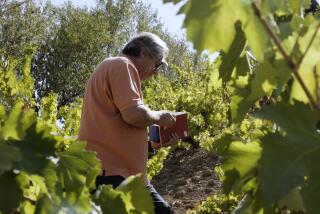What Makes This Wine Different From Others
- Share via
Regulations governing production of kosher wine are vague and subject to interpretation, but the basic requirement is that the wine be fermented in sterile vessels. This means all tanks, hoses and other equipment that come into contact with the fermenting juice or wine must be sterilized.
For a wine to be “kosher for all uses,” or mevushal, it must be pasteurized. In years past that meant boiling the wine, which often ruined the delicate flavors and aromas. But modern techniques that pass the grape juice through a chamber that heats the liquid to 185 degrees for less than a second are sufficient to “flash-pasteurize” the liquid.
For white wines, this is done to unfermented grape juice, and the resulting wine suffers little or no loss of character. Red wine juice, which contains skins and other solid matter, must be treated differently. When the fermentation is almost complete, it is flash-pasteurized while the wine is filled with carbon dioxide, which acts to protect it from damage.
Cream of the Crop
Tasting notes on some of the better kosher wines available on shelves today:
* 1995 Baron Herzog Chenin Blanc, Clarksberg ($6.50): Stunning aroma of melon and pear with hints of other tropical fruits. Slightly sweet, but perfectly balanced. A wine for sipping chilled or serving with slightly sweet food, such as Thai dishes.
* 1995 Baron Herzog Sauvignon Blanc, Shenandoah Valley ($8): Mild aroma of hay, fig and a trace of dried tea leaf. Soft yet totally dry, an elegant wine to serve with grilled fish.
* 1994 Hagafen Chardonnay, Napa Valley ($13.50): Racy tropical fruit with apple and spice, fresh and fruity on the tongue and rich yet dry finish. Good to serve with fish.
* 1994 Hagafen Chardonnay “Reserve,” Napa Valley ($17): Richer and fuller than the previous wine but still loaded with tropical fruit and apples, with a more creamy, oaky finish. Perfect with lobster bisque and other creamed dishes.
* 1993 Hagafen Cabernet Sauvignon, Napa Valley ($20): Fruit from the cool eastern Napa foothills of Coombsville, with an intense aroma of smoke, cassis and cedar, and a hint of mint jelly. Marvelously complex and deeply flavorful, a great match with lamb dishes.
More to Read
Eat your way across L.A.
Get our weekly Tasting Notes newsletter for reviews, news and more.
You may occasionally receive promotional content from the Los Angeles Times.







